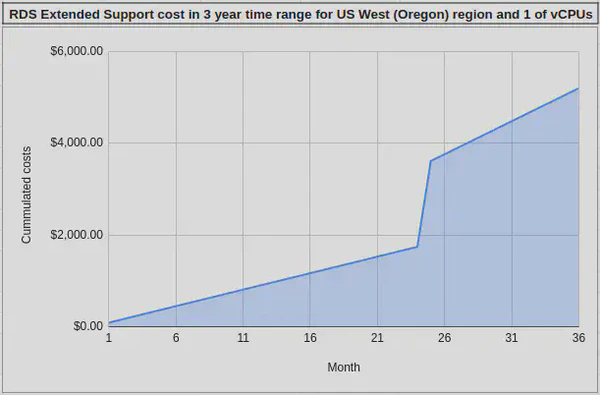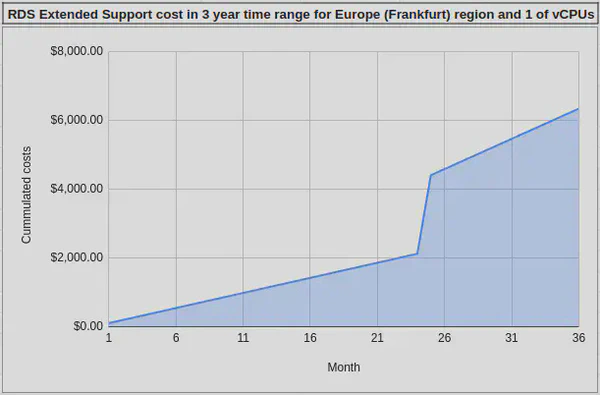Amazon recently faced challenges in maintaining support for legacy Relational Database Service (RDS) systems and even considered upgrading instances forcefully1. This situation is not unique to Amazon; many companies struggle with the costs of maintaining legacy systems. However, as a service provider, Amazon must support older systems as long as there are customers willing to pay for them.
In December 2023, Amazon announced1 plans to upgrade legacy RDS instances to versions still under active development, citing the rising costs of maintaining outdated systems. This included versions like MySQL 5.7 and PostgreSQL 10 (or earlier)2. However, instead of enforcing upgrades, Amazon introduced a new support approach: RDS Extended Support. This allows customers to continue using older versions, but with additional costs.
RDS Extended Support provides more time for users to upgrade to supported major engine versions while still receiving critical updates and support. For instance, support for MySQL 5.7 in RDS ends on February 29, 2024. Databases that do not upgrade by this date will be automatically enrolled in RDS Extended Support starting March 1, 2024, and will incur additional charges. This support is available for up to three years past the end-of-support date3.
The additional costs vary by region and can be significant, especially for large instances with many vCPUs. I was really interested how much it will cost?
Below is a table detailing the rise in costs per month per core by region:
Rise of Cost per Month/Per Core by Region
| Region | 1st year | 2nd year | 3rd year |
|---|---|---|---|
| US West (Oregon) | $72.00 | $72.00 | $144.00 |
| US West (N. California) | $80.64 | $80.64 | $161.28 |
| US West (Los Angeles) | $86.40 | $86.40 | $172.80 |
| US East (Ohio) | $72.00 | $72.00 | $144.00 |
| US East (N. Virginia) | $72.00 | $72.00 | $144.00 |
| South America (Sao Paulo) | $151.20 | $151.20 | $301.68 |
| Middle East (UAE) | $88.56 | $88.56 | $177.12 |
| Middle East (Bahrain) | $88.56 | $88.56 | $177.12 |
| Israel (Tel Aviv) | $84.96 | $84.96 | $169.20 |
| Europe (Zurich) | $96.48 | $96.48 | $193.68 |
| Europe (Stockholm) | $74.16 | $74.16 | $148.32 |
| Europe (Spain) | $80.64 | $80.64 | $161.28 |
| Europe (Paris) | $84.96 | $84.96 | $169.20 |
| Europe (Milan) | $84.96 | $84.96 | $169.20 |
| Europe (London) | $84.96 | $84.96 | $169.20 |
| Europe (Ireland) | $80.64 | $80.64 | $161.28 |
| Europe (Frankfurt) | $87.84 | $87.84 | $175.68 |
| Canada (Central) | $77.76 | $77.76 | $155.52 |
| AWS GovCloud (US-West) | $86.40 | $86.40 | $172.80 |
| AWS GovCloud (US-East) | $86.40 | $86.40 | $172.80 |
| Asia Pacific (Tokyo) | $86.40 | $86.40 | $172.80 |
| Asia Pacific (Sydney) | $86.40 | $86.40 | $172.80 |
| Asia Pacific (Singapore) | $86.40 | $86.40 | $172.80 |
| Asia Pacific (Seoul) | $86.40 | $86.40 | $172.80 |
| Asia Pacific (Osaka) | $86.40 | $86.40 | $172.80 |
| Asia Pacific (Mumbai) | $82.08 | $82.08 | $164.16 |
| Asia Pacific (Melbourne) | $86.40 | $86.40 | $172.80 |
| Asia Pacific (Jakarta) | $86.40 | $86.40 | $172.80 |
| Asia Pacific (Hyderabad) | $82.08 | $82.08 | $164.16 |
| Asia Pacific (Hong Kong) | $95.04 | $95.04 | $190.08 |
| Africa (Cape Town) | $95.76 | $95.76 | $191.52 |
You can calculate your costs with AWS Pricing Calculator .
Examples of Cost Impact in Specific Regions
Tables are not that easy to read, so let take a look at few examples on the graphs:
Oregon
It’s just a 1 vcore instance. My RDS instance have usually between 2~8 cores - that’s a lot of money burned!
Frankfurt
I run a lot of workloads here - costs in Europe are just higher 😐
Final words
This extended support strategy allows Amazon to manage the high costs of maintaining legacy systems while providing customers with the flexibility to plan their upgrades without immediate disruption. However, the cost can add up, especially for large, resource-intensive instances. I already planned upgrading mine.
https://aws.amazon.com/blogs/aws/your-mysql-5-7-and-postgresql-11-databases-will-be-automatically-enrolled-into-amazon-rds-extended-support/ ↩︎ ↩︎
https://docs.aws.amazon.com/AmazonRDS/latest/PostgreSQLReleaseNotes/postgresql-release-calendar.html ↩︎
https://aws.amazon.com/blogs/aws-cloud-financial-management/estimating-the-charges-for-amazon-rds-extended-support/ ↩︎
](https://gagor.pro/2024/04/rising-costs-of-running-legacy-amazon-rds-systems/images/cover.webp)

